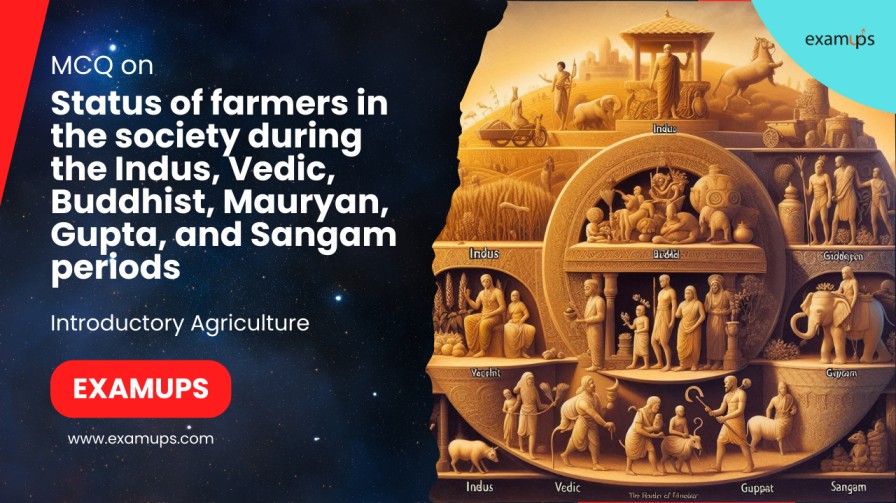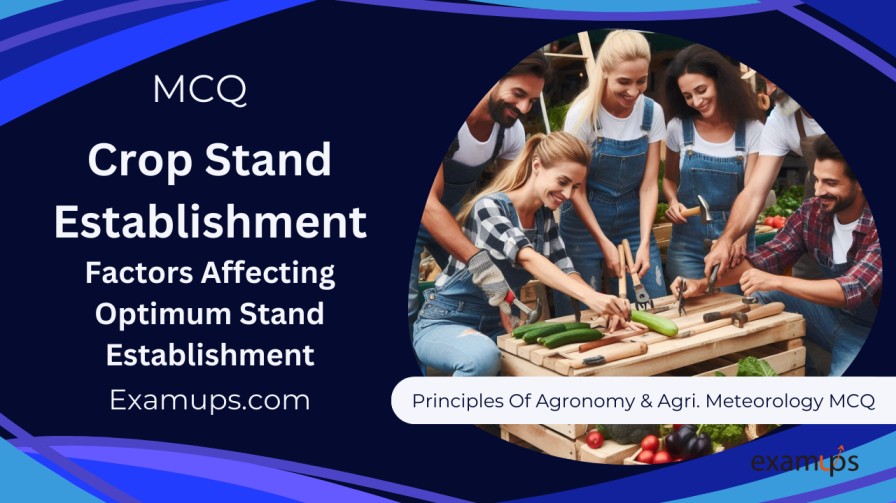MCQ on the Status of Farmers in Society during Historical Periods
This comprehensive set of Multiple-Choice Questions (MCQs) delves into the status and role of farmers in society across different historical periods, including the Indus Valley Civilization, Vedic Era, Buddhist Period, Mauryan Dynasty, Gupta Empire, and Sangam Age. The questions are meticulously crafted to cover various aspects such as the agricultural practices, economic importance, societal position, and contributions of farmers during these times.
Ideal for aspirants preparing for competitive exams like ICAR-JRF, ICAR-SRF, ICAR-NET, IBPS-AFO/SO, Pre-PG, BHU Pre-PG, IFFCO-AGT, CCI, FCI, as well as B.Sc and M.Sc students, this collection aims to provide a deep understanding of the evolution of agrarian society in ancient India. Each question is designed to test and enhance your knowledge, with a focus on historical insights that are crucial for excelling in agriculture-related exams.
1. During which period did the Indus Civilization emerge as the first farming culture in South Asia?
a) Vedic period
b) Mauryan period
c) Harappan period
d) Gupta period
**Answer: c) Harappan period**
Explanation: The Indus Civilization emerged as the first farming culture in South Asia during the
Harappan period, as described in the passage.
2. What was the primary occupation of the people during the Vedic period?
a) Trading
b) Hunting and gathering
c) Agriculture
d) Crafts and pottery
**Answer: c) Agriculture**
Explanation: Agriculture was the primary occupation during the Vedic period, with farmers
cultivating crops based on the advice of saints, as mentioned in the passage.
3. What characterized the economic system during the Buddhist period?
a) Feudalism with powerful landlords
b) Agricultural self-sufficiency in villages
c) Industrialization and urbanization
d) Nomadic lifestyle and herding
**Answer: b) Agricultural self-sufficiency in villages**
Explanation: The economic system during the Buddhist period was characterized by agricultural self
sufficiency in villages, with no landlords and villagers undertaking tasks collectively, as stated in the
passage.
4. Which term was used for the head of a rich land-owning family during the Mauryan period?
a) Gaha pathi
b) Vaishnava
c) Krishihala
d) Vellar
**Answer: a) Gaha pathi**
Explanation: During the Mauryan period, the head of a rich land-owning family was called “Gaha
pathi,” as mentioned in the passage.
5. What was the social status of cultivators during the Gupta period?
a) High social and economic status
b) Equal status with landowners
c) Low social and economic status
d) Nomadic lifestyle
**Answer: c) Low social and economic status**
Explanation: Cultivators during the Gupta period had low social and economic status, as indicated by
the various terms used to describe them, such as Krishihala or Kinars, as mentioned in the passage.
6. In which period was agriculture the main occupation, leading to a high status for farmers in
society?
a) Vedic period
b) Buddhist period
c) Mauryan period
d) Sangam period
**Answer: d) Sangam period**
Explanation: Agriculture was the main occupation during the Sangam period, leading to a high status
for farmers in society, as described in the passage.
7. What term was used for farmers during the Sangam period?
a) Vaishnava
b) Krishihala
c) Uzhavar
d) Gaha pathi
**Answer: c) Uzhavar**
Explanation: Farmers during the Sangam period were called “Uzhavar” or “plough man,” as
mentioned in the passage.
8. According to Thiruvalluvar, what is the significance of farmers in society?
a) They are worshipped as gods.
b) They live an independent life.
c) They have no importance compared to others.
d) They are dependent on others for survival.
**Answer: b) They live an independent life.**
Explanation: Thiruvalluvar emphasized the importance of farmers by stating that they alone live an
independent life, as mentioned in the passage.
9. Which period saw the emergence of urban centers from the Early Harappan communities?
a) Vedic period
b) Mauryan period
c) Harappan period
d) Gupta period
**Answer: c) Harappan period**
Explanation: Urban centers emerged from the Early Harappan communities during the Harappan
period, as stated in the passage.
10. What role did irrigation play in transforming the region during the Late Harappan period?
a) It led to the decline of agriculture.
b) It had no significant impact on the region.
c) It facilitated the growth of urban centers.
d) It caused environmental degradation.
**Answer: c) It facilitated the growth of urban centers.**
Explanation: Irrigation played a crucial role in transforming the region during the Late Harappan
period by facilitating the growth of urban centers, as mentioned in the passage.
11. What was the primary occupation during the Harappan period?
a) Trading
b) Farming
c) Fishing
d) Hunting
**Answer: b) Farming**
Explanation: The Harappan period saw the emergence of farming communities, with agriculture
being the primary occupation during this time, as mentioned in the passage.
12. During which Vedic period did farmers occupy a prominent position in society?
a) Rig Vedic period
b) Sama Vedic period
c) Yajur Vedic period
d) Atharvana Vedic period
**Answer: d) Atharvana Vedic period**
Explanation: Farmers occupied a more significant position in society during the Atharvana Vedic
period, as mentioned in the passage.
13. What was the economic status of farmers during the Mauryan period?
a) They were wealthy landowners
b) They were impoverished
c) They were state officials
d) They were traders
**Answer: b) They were impoverished**
Explanation: During the Mauryan period, the majority of the population were agriculturists, but the
economic status of farmers was low, as mentioned in the passage.
14. What was the primary occupation during the Sangam period?
a) Trading
b) Fishing
c) Agriculture
d) Mining
**Answer: c) Agriculture**
Explanation: Agriculture was the main occupation during the Sangam period, and farmers held a high
position in society during this time, as stated in the passage.
15. What term was used to refer to farmers during the Sangam period?
a) Vaishnavas
b) Krishihala
c) Uzhavar
d) Gaha pathi
**Answer: c) Uzhavar**
Explanation: Farmers during the Sangam period were referred to as “Uzhavar” or “plough man,” as
mentioned in the passage.
16. According to Thiruvalluvar, what role did farmers play in society?
a) They were worshipped as deities
b) They were revered as leaders
34
c) They were considered essential for survival
d) They were second to scholars and sages
**Answer: c) They were considered essential for survival**
Explanation: Thiruvalluvar emphasized the importance of farmers in society, stating that they alone
lived an independent life and were essential for the survival of others, as mentioned in the passage.
17. What was the economic condition of farmers during the Gupta period?
a) They were prosperous landowners
b) They were impoverished
c) They were state officials
d) They were traders
**Answer: b) They were impoverished**
Explanation: The economic condition of farmers during the Gupta period was low, as they were
referred to as Krishihala or Kinars and had a low social and economic status, as mentioned in the
passage.
18. What characterized the relationship between landowners and farmers during the Buddhist
period?
a) Pleasant proprietorship
b) Feudalistic hierarchy
c) Oppressive control
d) Economic exploitation
**Answer: a) Pleasant proprietorship**
Explanation: During the Buddhist period, there was pleasant proprietorship in rural areas, and while
there were landowners, there were no oppressive landlords, as mentioned in the passage.
19. How did irrigation transform the Harappan region?
a) It led to the development of urban centers
b) It facilitated trade and commerce
c) It increased agricultural productivity
d) It caused environmental degradation
**Answer: c) It increased agricultural productivity**
Explanation: By 2500 BCE, irrigation had transformed the Harappan region, increasing agricultural
productivity, as stated in the passage.
20. What were the primary crops cultivated during the Harappan period?
a) Rice and sugarcane
b) Wheat and barley
c) Millet and sorghum
d) Maize and potatoes
**Answer: b) Wheat and barley**
Explanation: During the Harappan period, farmers cultivated crops such as wheat and barley, as
mentioned in the passage.
21. During the Mauryan period, the majority of the population were engaged in:
a) Trade and commerce
b) Craftsmanship
c) Agriculture
d) Religious practices
**Answer: c) Agriculture**
**Explanation:** The Mauryan period was characterized by an agrarian economy, where the
majority of the population were involved in agriculture. This period saw significant advancements in
agricultural practices, including irrigation systems and land management.
22. In the Vedic period, the farmers were known as:
a) Brahmins
b) Shudras
c) Vaishyas
d) Kshatriyas
**Answer: c) Vaishyas**
**Explanation:** In the Vedic period, society was divided into four varnas, and the Vaishyas were
primarily responsible for agricultural activities. They cultivated the land and produced agricultural
products under the supervision of landowners.
23. Which period in ancient Indian history saw the emergence of a food-producing economy through
widespread agriculture with the use of iron implements?
a) Buddhist period
b) Gupta period
c) Sangam period
d) Mauryan period
**Answer: a) Buddhist period**
**Explanation:** The Buddhist period witnessed the emergence of a food-producing economy with
widespread agriculture. Iron implements were used extensively in agriculture during this period,
leading to increased agricultural productivity.
24. The Sangam period saw the development of agriculture in the region of:
a) Delhi
b) Madurai
c) Pataliputra
d) Varanasi
**Answer: b) Madurai**
**Explanation:** Agriculture flourished during the Sangam period, particularly in the region of
Madurai. The farmers, known as “uzhavar” or “Kalmar,” played a crucial role in society, contributing
to its economic prosperity.
25. During the Thirukural period, Thiruvalluvar emphasized the importance of farmers by stating
that:
a) Farmers are superior to kings
b) Farmers alone can ensure the prosperity of the kingdom
c) Farmers are the backbone of society
d) Farmers deserve the highest respect in society
**Answer: c) Farmers are the backbone of society**
**Explanation:** Thiruvalluvar, in his Thirukural, highlighted the essential role of farmers in society
by emphasizing that they are the backbone of society. This reflects the significance of agriculture in
sustaining the livelihoods of people during that period.
26. Which civilization had the first farming cultures in South Asia and emerged in the hills of what is
now called Baluchistan?
a) Vedic civilization
b) Harappan civilization
c) Mauryan civilization
d) Gupta civilization
**Answer: b) Harappan civilization**
**Explanation:** The Harappan civilization, also known as the Indus Valley civilization, had the first
farming cultures in South Asia. These farming communities emerged in the hills of Baluchistan and
gradually developed into larger settlements.
27. During the Indus Valley Civilization, farmers cultivated a variety of crops, including:
a) Rice and cotton
b) Wheat and barley
c) Millet and pulses
d) Sugarcane and sesame seeds
**Answer: b) Wheat and barley**
**Explanation:** During the Indus Valley Civilization, farmers cultivated crops such as wheat and
barley. These crops were crucial for sustaining the population of the urban centers that emerged
during this period.
28. Which period saw the transformation of Early Harappan communities into urban centers with
over 1052 cities and settlements discovered?
a) Late Harappan period
b) Vedic period
c) Mauryan period
d) Gupta period
**Answer: a) Late Harappan period**
**Explanation:** The Late Harappan period witnessed the transformation of Early Harappan
communities into urban centers. Over 1052 cities and settlements have been discovered from this
period, indicating significant urbanization.
29. In the Vedic period, the primary occupation of the majority of the population was:
a) Trade and commerce
b) Agriculture
c) Warfare
d) Religious practices
**Answer: b) Agriculture**
**Explanation:** Agriculture was the primary occupation of the majority of the population during
the Vedic period. The Vedic texts mention various agricultural practices and the importance of
farming in society.
30. During which period did the farmers in ancient India possess knowledge of fertility of land, seed
selection, and crop rotation?
a) Gupta period
b) Sangam period
c) Vedic period
d) Buddhist period
**Answer: c) Vedic period**
**Explanation:** In the Vedic period, farmers possessed knowledge about various aspects of
agriculture, including the fertility of land, selection of seeds, seed treatment, harvesting, manuring,
and rotation of crops. This period saw advancements in agricultural practices and technologies.
31. During which period did an agrarian economy emerge with widespread agriculture practiced
using iron implements?
a) Gupta period
b) Buddhist period
c) Mauryan period
d) Vedic period
**Answer: b) Buddhist period**
**Explanation:** The Buddhist period saw the emergence of an agrarian economy with widespread
agriculture practiced using iron implements. This period witnessed advancements in farming
techniques and increased agricultural productivity.
32. Which ancient Indian civilization had a well-developed system of irrigation, including the
construction of canals and wells?
a) Vedic civilization
b) Mauryan civilization
c) Harappan civilization
d) Gupta civilization
**Answer: c) Harappan civilization**
**Explanation:** The Harappan civilization had a well-developed system of irrigation, including the
construction of canals and wells. This sophisticated irrigation system played a crucial role in
supporting agricultural activities in urban centers.
33. In the Sangam period, agriculture was the main occupation, and farmers were known as:
a) Uzhavar
b) Krishihala
c) Kinars
d) Vellars
**Answer: a) Uzhavar**
**Explanation:** In the Sangam period, farmers were known as “Uzhavar.” Agriculture was the
primary occupation during this period, and farmers played a significant role in the economy and
society of ancient South India.
34. Which ancient Indian text mentions the importance of farmers in society through verses praising
their independence and contributions?
a) Ramayana
b) Mahabharata
c) Arthashastra
d) Thirukural
**Answer: d) Thirukural**
**Explanation:** Thirukural, a classical Tamil text composed by Thiruvalluvar, mentions the
importance of farmers in society through verses praising their independence and contributions to
sustaining life.
35. During the Mauryan period, the head of a rich landowning family was known as:
a) Gaha Pathi
b) Uzhavar
c) Krishihala
d) Kinars
**Answer: a) Gaha Pathi**
**Explanation:** During the Mauryan period, the head of a rich landowning family was known as
“Gaha Pathi.” This term denoted their status and authority in agricultural matters.
36. Which ancient Indian civilization had a sophisticated granary system for storing food grains?
a) Vedic civilization
b) Buddhist civilization
c) Harappan civilization
d) Gupta civilization
**Answer: c) Harappan civilization**
**Explanation:** The Harappan civilization had a sophisticated granary system for storing food
grains. These granaries were crucial for ensuring food security in urban centers and played a vital role
in the economy.
37. During which period was the practice of off-season plowing recognized as important for
agricultural success?
a) Gupta period
b) Vedic period
c) Harappan period
d) Mauryan period
**Answer: b) Vedic period**
**Explanation:** In the Vedic period, the practice of off-season plowing was recognized as important
for agricultural success. This period saw advancements in agricultural techniques and the cultivation
of various crops.
38. Which ancient Indian civilization is associated with the term “Lemuria,” a hypothetical sunken
continent or land bridge?
a) Mauryan civilization
b) Harappan civilization
c) Vedic civilization
d) Buddhist civilization
**Answer: b) Harappan civilization**
**Explanation:** The term “Lemuria” is associated with the Harappan civilization. It refers to a
hypothetical sunken continent or land bridge that connected India and other regions across the
Indian Ocean.
39. During the Sangam period, agriculture flourished mainly in which region of India?
a) Northern India
b) Eastern India
c) Western India
d) Southern India
**Answer: d) Southern India**
**Explanation:** During the Sangam period, agriculture flourished mainly in Southern India. This
region was known for its fertile lands, extensive irrigation systems, and agricultural productivity.
40. Which ancient Indian text mentions the utilization of wells for irrigation purposes, known as
“kucha wells”?
a) Arthashastra
b) Manusmriti
c) Ramayana
d) Mahabharata
**Answer: c) Ramayana**










